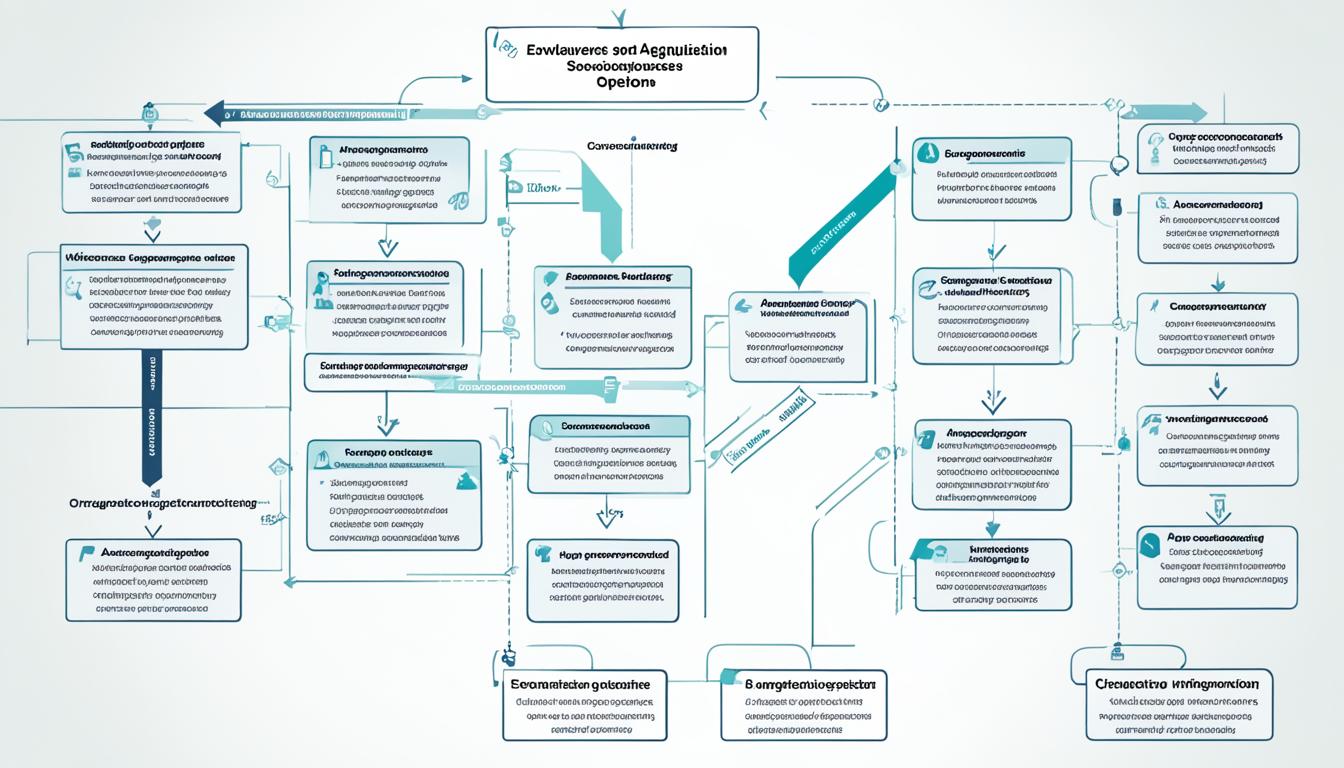In today’s business world, picking the right software acquisition options is very important. Choosing the best software solution is more than what you like. It is essential for your business success. Companies need to carefully assess their options to make sure they match up with their business goals. With the right software procurement strategies, businesses can stay ahead, innovate, and improve how they work.
Key Takeaways
- Strategic review of software options ensures business needs are met.
- Robust procurement strategies enhance operational efficiency.
- Selection of software is crucial for maintaining a competitive edge.
- Thorough assessment aligns technology with organizational goals.
- An effective acquisition process is central to innovation and growth.
Understanding the Software Acquisition Pathway
Getting software involves a complex journey that keeps evolving with technology and business needs. It requires focusing on strategic steps and understanding development stages for success.
Key Phases: Planning and Execution
The planning phase is crucial in the software acquisition process. Here, organizations decide their goals and user needs. This guides their software acquisition pathway. Next, the execution phase begins. This is where plans become reality. Designing, developing, integrating, and deploying the software happen here.
Involvement of Test and Evaluation Teams
Test and evaluation teams play a key role. They ensure the software meets quality and effectiveness standards. Their expertise checks software performance from start to finish, ensuring constant improvement.
Applications vs. Embedded Software Paths
It’s important to know the differences between applications path and embedded software path. Application software is for users. Embedded software works within hardware. Each path has its development cycles, testing, and deployment needs.
Iterative Development and DevSecOps Fundamentals
The latest approach to software development emphasizes iterative development and DevSecOps fundamentals. This method allows for quick adaptations. It also builds in security at every step, making software secure and agile.
Strategic Planning for Software Procurement
In our fast-changing digital world, software solution assessment is key for a strong software buying plan. Picking software that fits your company’s goals and needs is vital. You need a planned approach. Software evaluation methods should be a major part of this plan. When getting new software, you must look at different factors to ensure it will work well for a long time.
Starting the process, a company needs to fully understand what it needs. This means doing a detailed software purchase analysis. It’s important to choose technology that meets today’s needs and can grow with the company. Also, checking decision-making criteria for software acquisition helps avoid problems with new systems.
Having support from top management is vital from the start. It helps set the strategic path and resources. Also, it’s important to involve key people from different areas. This way, many viewpoints help make a good choice.
For a smooth planning process for buying software, do these important steps:
- Gather detailed needs from each department
- Look at your IT setup for possible ways to add on
- Check for data security and rules you need to follow
- Talk to IT experts about updating or reusing systems
- Do thorough market research to find the best software options
Doing a clear and detailed evaluation makes sure your final choice fits current and future needs in the market.
Creating a checklist for evaluating choices is crucial. Here’s an example of what to look at when choosing software:
| Criteria | Description | Priority Level |
|---|---|---|
| User Accessibility | Ease of use for all levels of tech skill. | High |
| Integration Compatibility | How well it works with your current systems. | Medium |
| Scalability | How well it can grow with your company. | High |
| Technical Support | How good is the support from the vendor. | Medium |
| Cost Efficiency | Includes buying, setting up, and keeping the software. | High |
| Security Compliance | Meets specific industry security rules. | High |
By setting up a smart and informed software buying process, companies can be innovative and forward-thinking. With all the software solution assessment resources available now, businesses can make wise choices. These choices should fit their long-term plans and tech needs.
Software Evaluation Methods for Informed Decision Making
Choosing the right software options demands effective software evaluation methods. As technology becomes central to businesses, analyzing software acquisition options carefully is crucial. This evaluation should use criteria linked to organizational needs and a detailed look at vendors.
Defining Clear Evaluation Criteria
To evaluate software properly, we need clear criteria. These standards cover everything from functions and scalability to cost. With these in place, choosing the right software vendors becomes objective and aligned with the org’s goals.
Non-Discriminatory and Comprehensive Information Standards
Using non-discriminatory language and thorough standards is key. It ensures fair, unbiased comparisons across different software. The goal is transparency and fairness in assessing each option.

Assessing User Engagement and Interaction
Analyzing user engagement with software is essential. It involves checking if the software is easy to use and helps users finish tasks smoothly. Good software provides helpful feedback, guidance, and strong support.
Technical Reliability and Support Services Considerations
Lastly, reliability and support are crucial. These aspects confirm the software’s performance and ongoing support quality. Looking at software consistency and how quickly vendors fix issues leads to dependable choices.
| Criteria | Importance | Evaluation Method |
|---|---|---|
| Functionality | High | Feature comparison, user testing |
| User Interface | Medium | User experience surveys, expert reviews |
| Integration | High | Technical assessment, compatibility testing |
| Cost | Variable | ROI analysis, total cost of ownership calculations |
| Support Services | High | Vendor response time tracking, support service reviews |
Evaluating Software Acquisition Options
When looking for new software, organizations need to consider many things. They should carefully analyze their options. This helps ensure they pick the best tools to meet their goals and fit their current tech set-up.

Evaluating software acquisition options isn’t just about cost. It’s about finding out if the software will work well, grow with your needs, and integrate easily. Organizations should set clear criteria for what makes a tool a good fit. This includes how well it performs, its ease of use, and if it supports their workflow and future plans.
Choosing the right software signifies a commitment to boosting operational efficiency and driving business success.
When comparing software, companies often use matrices. They list the competing software tools and how they stack up on important aspects.
- Does the software meet our specific needs?
- Is it easy for our team to use?
- What kind of support is offered?
- Can it grow with our business?
The software purchase analysis goes deep into seeing if the software helps achieve key goals. These could be increasing productivity, making data analysis better, or improving customer services. Every step, from figuring out what you need to the final choice, must focus on how the software benefits the business now and in the future.
| Criteria | Software A | Software B | Software C |
|---|---|---|---|
| Functionality | Comprehensive suite | Limited by design | Customizable |
| Compatibility | Full integration | Requires workarounds | Natively supportive |
| User-Friendliness | Easy onboarding | Steep learning curve | User-centric design |
| Technical Support | 24/7 service | Business hours only | Community-driven |
By comparing software tools this way, using both numbers and deeper insights, businesses can avoid making costly mistakes. Making a well-informed decision not only improves how things work day-to-day. It also makes the company quicker to adapt to changes, which is critical in our fast-moving world.
Selecting the Best Software Solution Through Rigorous Analysis
In the dynamic world of tech, selecting the best software solution is key for businesses keen on growth. A detailed software purchase analysis is crucial when looking at the many choices available. It lets companies greatly increase their chances of finding software that fits their needs now and in the future.
Starting with a detailed look at what the organization needs, the analysis matches these with what each software offers. This careful approach makes sure the choice works well in everyday tasks. Comparing software tools on their performance, scalability, user experience, and how they mesh with current systems is vital.
| Evaluation Criteria | Description | Benefit |
|---|---|---|
| User Needs Fulfillment | An assessment of how well the software meets specific user requirements. | Boosts user satisfaction and productivity. |
| Technical Specifications | A look at the software’s technical build and its fit with existing setups. | Makes sure of smooth integration and compatibility. |
| Vendor Reliability | Checking the vendor’s market position, customer service, and support track record. | Builds trust in a lasting software partnership. |
| Support Services | How available and good the vendor’s support is after buying. | Helps with ongoing maintenance and fixing issues. |
| Business Objectives Alignment | How the software helps achieve key business goals. | Aids in business success and expansion. |
By looking into these criteria, companies not only better their current operations but also prepare for future changes. This mix of forward thinking, accuracy, and practical application turns the chosen software into a valuable asset. Going on the journey of selecting the best software solution combines art and science. It uses careful analysis to create results that push a business forward.
The Role of Vendor Demonstrations and Reference Checks
Understanding how to choose software is key. Software procurement strategies are vital, especially vendor demonstrations and reference checks. They help see if the software will work well in your company. Evaluating software vendors involves looking closely at demos and what past customers say.
Demos let you see the software in use. This is better than just hearing about what it can do. You can check the software’s design and features. Plus, see if it’s easy to use and if it will fit in with your other tools. When you look at the software yourself, you find out things you can’t get from just reading about it.
- Observe the product in a real-world scenario
- Interact with the user interface
- Identify any potential integration challenges
- Assess ease of use and functionality
Reference checks are also crucial for evaluating software vendors. You talk to the vendor’s current or former clients. This lets you learn if they are happy with the software and the support they got. You can learn a lot about the software and the vendor by listening to others’ experiences.
Reference checks provide an assessment of vendor reliability and client satisfaction through the experiences of established customers.
In conclusion, doing vendor demonstrations and reference checks is important. It’s a key part of software procurement strategies. This approach helps companies thoroughly check out software solution assessment. It ensures they find the best software and vendor for their needs.
Finalizing the Software Acquisition with Well-Informed Contracts
The software acquisition process ends with crafting well-informed contracts. These contracts act as a guide for the business relationship between a company and a software vendor. Understanding the terms, duties, and promises in these documents is critical.
It ensures that both sides keep their promises, leading to a successful partnership. Drafting contracts and procurement documents carefully is key to great software procurement strategies. Transparent terms about the work, budget, and timeline help avoid risks and set clear, beneficial expectations for everyone involved.
In the world of contracts and procurement, having the right knowledge is crucial. Companies need to know their spending limits and understand different types of vendor documents. These documents include Requests for Information (RFIs), Requests for Quotations (RFQs), and Requests for Proposals (RFPs).
Being thorough is vital for sticking to high standards of security and procurement rules. Dealing with any vendor, big or small, requires contracts that follow legal and policy guidelines strictly. These guidelines might come from the Office of Contracts and Procurement.
Signing a software contract is a big moment. It influences the company’s future directions and opportunities. Therefore, companies look for contracts that are fair, clear, and protect their interests.
Details like service levels, deliverables, and technical support should not be vague. A contract, crafted with care, guarantees that the company picks the right software. This choice paves the way for technological growth and achieving strategic targets.
FAQ
What are the key phases in the software acquisition pathway?
How do test and evaluation teams contribute to software acquisition?
What is the difference between applications and embedded software paths?
Why is iterative development and DevSecOps important in software procurement?
What comprises strategic planning for software procurement?
How are clear evaluation criteria defined in software evaluation?
Why is non-discriminatory and comprehensive information important in software acquisition?
What factors should be considered when assessing user engagement and interaction in software evaluation?
Why are technical reliability and support services considerations crucial in software selection?
What role do vendor demonstrations and reference checks play in the software acquisition process?
What are the important aspects to consider when finalizing software acquisition contracts?
Source Links
- https://its.humboldt.edu/sites/default/files/docs/po-docs/Software Selection Process 09-12.pdf
- https://www.test-evaluation.osd.mil/Portals/120/Documents/TE Enterprise Guidebook/Ch5 from TE Enterprise Guidebook 8.02.pdf?ver=7g0ErIbnox_eSeN63K-KIQ==
- https://ncda.org/aws/NCDA/asset_manager/get_file/3404/softwareevaluationcriteria.pdf



